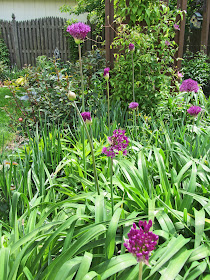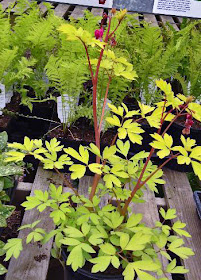I have never had a rose bloom in April! My roses bloom in June, but not this Rainbow Knockout that looks like it has a little frostbite.
Endless Summer Hydrangea (has not been a good bloomer in my area) has also been nipped but it looks like it has lots of buds this year. I did not cut it back at all this year and held off on the fertilizer (just a light sprinkle). This may not be the best year to judge the results because of our milder winter.
Some of the Type 2 clematis are blooming. This one is Bourbon, grows about six feet high and I will have to cover it again for the patchy frost warning.
This is Ramona and also is a type 2, can't cover this one because it's on the arbor.
Type 2 clematis are a little more work in that they require careful pruning in the spring and every so often need to be cut down after blooming to rejuvenate them and get rid of a lot of dead wood. I think it is worth growing some of them because of their early bloom and large flowers.
Wow, I have never had this many berries forming on Amelanchier Regent, birds will love it!
Allium in the border takes up hardly any room, a great bulb to layer where there is lots of other foliage to hide the ripening leaves.
I am going to use less annual fillers in the border this year, impatiens are susceptible to downy mildew, and these are what I have usually interplanted. I am thinking Verbena Bonariensis might work well and take up little space.
I have given up trying to reposition my pansies in other areas, the heat always gets them!
Foolproof perennials, Heuchera Villosa Purpurea, Heuchera Southern Comfort, Heuchera Pistache and Japanese Painted Fern all happy together in part shade.
Raspberry Splash Pulmonaria looks better as the season goes on, decorative leaves all summer.
Persicaria Polymorpha is creeping up towards the grid, hope it holds it firm this year during the storms. It is such a striking plant and will bloom all summer if not whipped around by the wind.
The carex grass has just about covered the fencing that keeps it off the path.
This might be the year for Thunderbolt Hosta, not very pretty when there are only two or three leaves.
Rainbow Knockout
It is important to prune your roses each year, opening up the center, taking out all stems that are pencil thin and leaving some thicker and thinner canes. Don't forget to feed them and they will reward you with gorgeous blooms. I bring mine down to about twelve inches and they fill out and up beautifully!
Have a wonderful weekend!































































